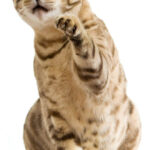The concept of a Bunny Cat Hybrid, often playfully termed a “cabbit” or “rabcat,” has intrigued and baffled animal enthusiasts for generations. While the idea of such a crossbreed might initially seem far-fetched, especially when compared to commonly dismissed animal hybrids like cat-dog or cat-raccoon, the notion of a bunny cat hybrid is surprisingly persistent and, in some corners, even fiercely defended. In fact, the existence of the bunny cat hybrid is supported by a wealth of anecdotal evidence, including numerous videos purportedly showing these unusual creatures and countless eyewitness accounts from individuals claiming to have encountered them.
Is the bunny cat hybrid merely a product of folklore and wishful thinking, or could there be a kernel of truth behind these persistent claims? Let’s delve into the intriguing world of the alleged bunny cat hybrid and examine the evidence, skepticism, and scientific arguments surrounding this captivating creature.
One of the most compelling pieces of evidence cited by proponents of the bunny cat hybrid is the existence of a peculiar animal in Tucuman, Argentina. This creature, often showcased in online videos, appears to possess the distinct physical characteristics of both a cat and a rabbit. The front portion of its body strikingly resembles that of a domestic cat, while the rear half exhibits rabbit-like features. Adding to the intrigue, the Tucuman animal’s locomotion is distinctly rabbit-like – it hops rather than moves with feline grace.
Article continues below
The Tucuman animal, often cited as visual evidence for the existence of a bunny cat hybrid, showcasing a feline front and rabbit-like rear.
Explore more cabbit videos >>
Read firsthand reports about cabbits >>
Do Bunny Cat Hybrids Actually Exist? The Cabbit Controversy
Despite the compelling visual evidence and numerous testimonials, the existence of bunny cat hybrids remains a subject of intense debate and skepticism. Many dismiss the idea outright, often with ridicule. Historically, naturalists like Francis Trevelyan Buckland, a 19th-century figure, attributed purported bunny cat hybrids to being nothing more than Manx cats afflicted with birth defects. Buckland famously quipped, highlighting the need for a “rabbit with a long tail” to prove hybridity, implying the absurdity of the claims.
However, counter to this skepticism, ardent proponents of the bunny cat hybrid vehemently assert their reality. One such proponent, in an email quoted by Sarah Hartwell (who herself argued against cabbit possibility), passionately declared cabbits as “real” and “abundant,” especially in Ontario. This individual claimed personal experience breeding cabbits and dismissed any scientific doubt as unfounded, emphasizing the hybrid’s rabbit-like hind legs, soft fur, silent nature, and hopping gait.
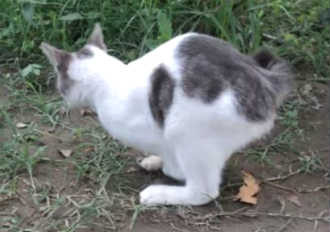 cabbit
cabbit
A close-up image of the Tucuman animal’s hind feet, demonstrating the plantigrade stance characteristic of rabbits, further fueling the bunny cat hybrid debate.
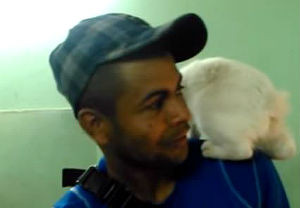 cabbit
cabbit
A screenshot from a video collection of alleged bunny cat hybrids, highlighting the rabbit-like rear portion of the animal, contrasted with its feline front.
Watch video evidence and decide for yourself >>
The debate surrounding bunny cat hybrids often devolves into polarized viewpoints, with each side accusing the other of ignorance or deliberate misinformation. Initially, even the author of the original article admitted to dismissing the possibility of such a distant hybrid. However, exposure to numerous videos showcasing creatures that visually resemble bunny cat hybrids on platforms like YouTube has prompted a reconsideration. The call for genetic testing of these animals remains unanswered, leaving the question of their true nature unresolved.
Interestingly, documented instances of male rabbits (bucks) attempting to mate with female cats are readily available, particularly on video-sharing platforms. Furthermore, collections of videos specifically showcasing purported bunny cat hybrids are easily accessible online. These videos consistently depict “cats” with rabbit-like hindquarters and a distinct hopping locomotion, fueling speculation about their hybrid status beyond mere birth defects in Manx cats. This evidence, while not conclusive, strongly suggests the need for deeper investigation into the bunny cat hybrid phenomenon. Genetic analysis, specifically DNA testing, could definitively resolve the debate, particularly if these creatures are indeed first-generation (F₁) hybrids, making genetic verification straightforward.
Adding another layer of complexity, cats have been observed nursing and raising rabbits. This interspecies nurturing behavior is significant because of the phenomenon of imprinting. Animals raised by a different species may, upon reaching sexual maturity, exhibit a preference for mating with individuals of their foster species rather than their own. This imprinting could potentially lead to hybridization, setting the stage for bunny cat hybrid offspring if interspecies breeding were biologically possible.
Article continues below
A cat nursing a litter of rabbits, illustrating the phenomenon of interspecies nurturing that could potentially contribute to imprinting and cross-species mating preferences.
Rabbits raised by cats might, due to imprinting, develop a sexual preference for cats, thus increasing the likelihood of cat-rabbit mating attempts and, hypothetically, cabbit production. If Manx cats, known for their rabbit-like rear ends and hopping gait, are indeed of hybrid origin, as some theories suggest, the European rabbit (Oryctolagus cuniculus), the only rabbit species native to the Isle of Man, would be the likely rabbit parent. The prevalence of European rabbits as an invasive species in many parts of the world and the popularity of domestic rabbit breeds further complicate the potential for interspecies interactions and alleged hybridization.
Debunking the “Impossible”: Why the Bunny Cat Hybrid Myth Persists
Despite the anecdotal evidence and persistent claims, the scientific community largely dismisses the possibility of bunny cat hybrids. Several arguments are commonly raised to support this stance, often based on fundamental biological principles. However, closer examination reveals that these arguments may not be as insurmountable as they initially appear.
Chromosome Count and Genetic Compatibility: One frequently cited argument against bunny cat hybrids is the difference in chromosome numbers between cats (2n=38) and rabbits (2n=44). It is asserted that this chromosomal disparity renders hybridization impossible. However, this argument is contradicted by numerous documented instances of successful hybridization between mammalian species with even greater differences in chromosome numbers. Sheep and goats, for example, differ by six chromosomes, the same difference as between cats and rabbits, yet are known to produce hybrids, albeit rarely. This demonstrates that chromosomal differences alone do not automatically preclude hybridization.
Gestation Period Discrepancies: Another common objection revolves around the difference in gestation periods between cats (approximately 64 days) and rabbits (around 31 days). The argument suggests that this temporal mismatch makes hybrid development impossible. However, this claim also lacks universal validity. The existence of the cama, a hybrid of the dromedary camel (13-month gestation) and llama (11-month gestation), and the wolphin, a hybrid of the false killer whale (15.5-month gestation) and bottlenose dolphin (11.5-month gestation), clearly demonstrates that significant differences in gestation periods do not necessarily prevent successful hybridization. These examples, along with pig-babirusa hybrids exhibiting a 33% gestation period difference, challenge the notion that gestation period discrepancies are a barrier to hybridization.
Genetic Distance and Evolutionary Divergence: The argument of excessive “genetic distance” and evolutionary divergence between cats and rabbits is also frequently invoked. While cats and rabbits are undoubtedly distinct species, the precise degree of genetic difference that absolutely prevents hybridization remains unknown. Hybridization, by definition, involves genetically distinct parents, and the limits of genetic compatibility in hybridization are still being explored. The very existence of alleged bunny cat hybrids could potentially offer valuable insights into these limits.
Anatomical and Evolutionary “Difference”: Similar to genetic distance, arguments based on anatomical and evolutionary “difference” are often raised. However, hybridizing species typically exhibit anatomical differences, and the extent of permissible anatomical divergence for hybridization is not definitively established. Likewise, the limits of evolutionary relatedness in hybridization remain unclear. The case of the bunny cat hybrid, if proven true, could push the boundaries of our understanding of these limits.
 cat-rabbit hybrid
cat-rabbit hybrid
An artist’s depiction of a hypothetical cat-rabbit hybrid, illustrating the combined features of both species, prompting further inquiry into the biological plausibility of such a creature.
Fertility and the Manx Cat Misconception: Some skeptics point to the Manx cat breed, known for its taillessness and rabbit-like features, as proof against bunny cat hybrids. They argue that since Manx cats are fertile and breed true, they cannot be hybrids, as hybrids are generally considered sterile. This argument, however, relies on flawed premises. Many documented hybrid crosses produce fertile or partially fertile offspring. Furthermore, numerous fertile domestic breeds are known to have originated from hybridization events. Therefore, the fertility of Manx cats does not automatically exclude the possibility of hybrid origin.
The Enigmatic “Manx Gene”: Interestingly, Manx cats are not as fertile as typical domestic cats and are known to have a higher rate of stillbirths and offspring with congenital issues, a characteristic often associated with hybrids. This reduced viability is often attributed to the hypothetical “Manx gene.” However, no formal scientific study has definitively characterized or even mapped this “Manx gene” to a specific chromosome, raising questions about its true nature and potential link to hybridity.
Article continues below
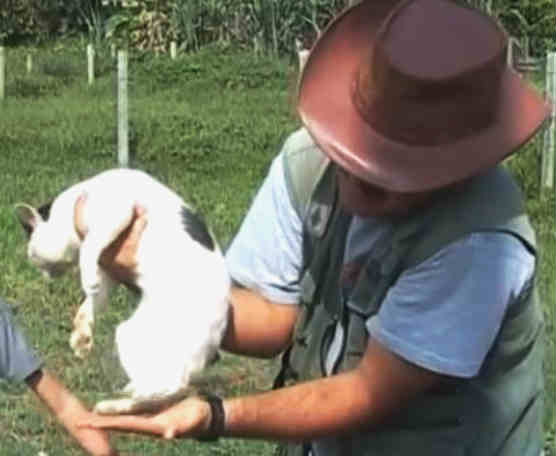 Cabbit
Cabbit
Another visual representation of a cabbit, sourced from online video footage, emphasizing the ongoing visual evidence supporting the bunny cat hybrid narrative.
Concluding Thoughts: Mutation or Hybridization? The Simpler Explanation
In conclusion, while the scientific community remains largely unconvinced, the persistent anecdotal evidence and the challenges to common counterarguments warrant a more open-minded consideration of the bunny cat hybrid phenomenon. One could, as skeptics propose, attribute the rabbit-like features of Manx cats and alleged cabbits to a series of coincidental mutations in domestic cats. This mutation-based explanation would require assuming that these mutations coincidentally resulted in rabbit-like hindquarters, hopping locomotion, dietary preferences (carrots, lettuce, grass), and the various health issues observed in Manx cats. Furthermore, it would necessitate believing that breeders could, through selective breeding of ordinary cats, eventually produce animals with hindquarters virtually indistinguishable from those of rabbits, all through unknown genetic mutations.
However, as Samuel Johnson famously stated, “the solution as I have given it, is plain.” Is it not a simpler and more straightforward explanation to consider that Manx cats and alleged cabbits exhibit rabbit-like traits, reduced fertility, and hybrid-associated health issues precisely because they are, in fact, bunny cat hybrids? The question remains: are we willing to dismiss compelling visual evidence and anecdotal accounts in favor of complex and perhaps less parsimonious explanations, or is it time to seriously consider the possibility, however improbable it may seem, of the elusive bunny cat hybrid? Further investigation, particularly through genetic testing, is crucial to definitively resolve this enduring zoological mystery.
Explore more cabbit videos >>
Read more firsthand reports about cabbits >>
A Catalog of Reported Cat Crosses
The following list showcases reported instances of cat hybridization with various other species. The reliability of these reports varies significantly, as indicated. While some crosses are well-documented, others remain highly questionable and may seem biologically implausible. Nevertheless, all listed crosses have been reported at least once, highlighting the breadth of perceived (and sometimes real) hybridization possibilities involving cats. Click on the links for detailed articles on each crossbreed.
Sheep-pig hybrids?
| ![reliability arrow]() |
|---|
Cat × Wildcat >>
Lion × Tiger >>
Jaguar × Lion >>
Leopard × Lion >>
Jaguar × Leopard >>
Cat × Pallas’s Cat >>
Cat × Rabbit (Cabbits) >>
Cat × Marten >>
Leopard × Tiger >>
Cat × Dog >>
Cat × Raccoon >>
Cat × Possum>>
Cat × Chicken >>
Cat × Kangaroo>>
Puma × Bear >>
Puma × Dog >>
Cat × Duck >>
Cat × Human >>
Cat × Rat >>
Cat × Opossum >>
Cat × Squirrel >>
Cat × Horse >>
| Most Popular Reads on Macroevolution.net: Human Origins: Are we hybrids? On the Origins of New Forms of Life Mammalian Hybrids Cat-rabbit Hybrids: Fact or fiction? Famous Biologists Dog-cow Hybrids Georges Cuvier: A Biography Prothero: A Rebuttal Branches of Biology Dog-fox Hybrids |
|---|
Cat-rabbit Hybrids – © Macroevolution.net

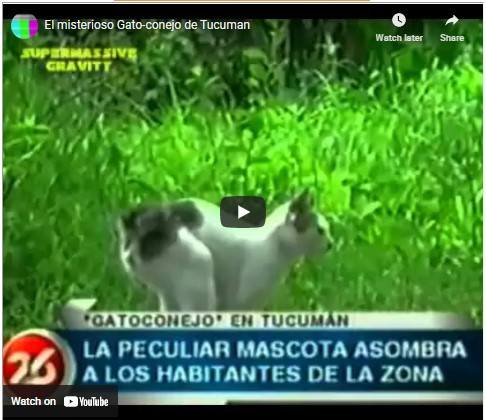
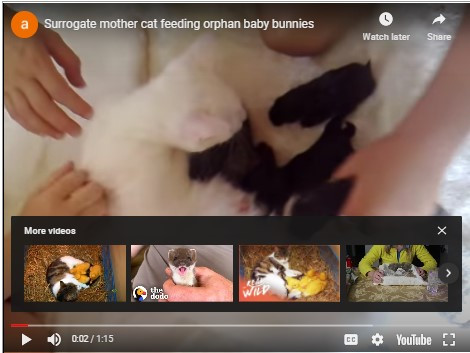 cat nursing rabbits
cat nursing rabbits